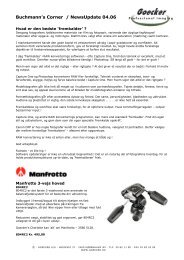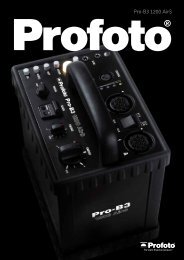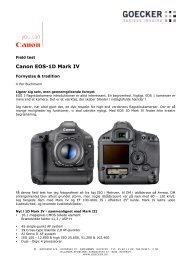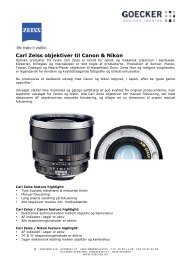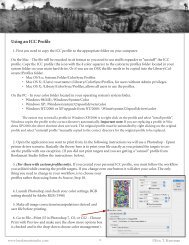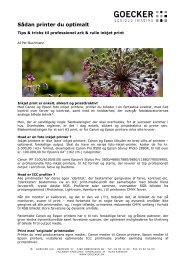Using M8 + Tri-Elmar-M 4 16-18-21 + UV/IR filter - Leica Camera AG
Using M8 + Tri-Elmar-M 4 16-18-21 + UV/IR filter - Leica Camera AG
Using M8 + Tri-Elmar-M 4 16-18-21 + UV/IR filter - Leica Camera AG
Create successful ePaper yourself
Turn your PDF publications into a flip-book with our unique Google optimized e-Paper software.
<strong>Using</strong> the LEICA <strong>M8</strong>, firmware version 1.102 with the<br />
LEICA TRI-ELMAR-M <strong>16</strong>-<strong>18</strong>-<strong>21</strong>mm f/4 ASPH. and a LEICA <strong>UV</strong>/<strong>IR</strong> <strong>filter</strong><br />
About the lens<br />
The LEICA <strong>M8</strong> has an increased sensitivity to infrared light. This manifests itself in a slightly purple<br />
rendering of dark or black surfaces (particularly black textiles). <strong>Using</strong> the LEICA <strong>UV</strong>/<strong>IR</strong> <strong>filter</strong> in front<br />
of the lens effectively prevents this from occurring.<br />
When using wide-angle lenses from <strong>16</strong> to 35mm with the LEICA <strong>UV</strong>/<strong>IR</strong> <strong>filter</strong>, a focal length specific<br />
correction of the color cast towards the edge of the image is required. With 6-bit coded lenses, this is<br />
done automatically in the camera as the lens type is transferred to the LEICA <strong>M8</strong> as part of the<br />
coding. However, in the case of the LEICA TRI-ELMAR-M <strong>16</strong>-<strong>18</strong>-<strong>21</strong>mm f/4 ASPH., the lens type<br />
transferred does not always correspond to the focal length actually set on the lens. Additional<br />
information is therefore required. When the LEICA <strong>M8</strong> is being operated with the Firmware version<br />
1.10 (or higher), the focal length specific correction is possible for this lens too. To do this, the<br />
Firmware version includes an extended menu:<br />
1. Under the menu item „Lens detection“, select the sub-point “On + <strong>UV</strong>/<strong>IR</strong>” by pressing the SET<br />
button. A new monitor screen appears with the title „Lens detection <strong>Tri</strong>-<strong>Elmar</strong> + <strong>UV</strong>/<strong>IR</strong>”.<br />
Note:<br />
Provided “On + <strong>UV</strong>/<strong>IR</strong>” has previously been set, this monitor screen appears automatically as<br />
soon as the camera is turned on and/or the LEICA TRI-ELMAR <strong>16</strong>-<strong>18</strong>-<strong>21</strong>mm f/4 ASPH is<br />
attached, regardless of whether or not the monitor was previously active.<br />
2. In the box with a red border, the three focal lengths <strong>16</strong>, <strong>18</strong>, and <strong>21</strong>mm can be selected using<br />
the direction buttons and/or the central adjusting dial and confirmed as normal with the SET<br />
button.<br />
Notes:<br />
• The setting in the menu must be made every time the focal length on the lens is<br />
changed.<br />
• When the lens is attached, the middle focal length of <strong>18</strong>mm is always preselected.<br />
• This manual adjustment of the focal length in the menu is only necessary with the<br />
LEICA TRI-ELMAR-M <strong>16</strong>-<strong>18</strong>-<strong>21</strong>mm f/4 ASPH. The LEICA TRI-ELMAR-M 28-35-50mm<br />
f/4 ASPH. features the necessary mechanical transfer of the set focal length to the<br />
camera to display the appropriate bright-line frame in the viewfinder. The camera<br />
electronics detect the setting and use it to perform focal length specific correction.<br />
Page 1 of 2 / As at April 2007<br />
<strong>Leica</strong> <strong>Camera</strong> <strong>AG</strong> / Oskar-Barnack-Straße 11 / D-35606 Solms / Telephone +49 (0) 6442-208-0 / Telefax +49 (0) 6442-208-333 / www.leica-camera.com
About the <strong>filter</strong><br />
• The LEICA <strong>UV</strong>/<strong>IR</strong> <strong>filter</strong> combined with lenses from <strong>16</strong>-28mm focal length should not be used<br />
for shots under fluorescent light (fluorescent tubes). As fluorescent tubes emit light with a<br />
very uneven spectrum, this could result in incorrect color correction.<br />
• As with all optical <strong>filter</strong>s placed in front of the shooting lens and strong light sources in the<br />
picture, using the LEICA <strong>UV</strong>/<strong>IR</strong> <strong>filter</strong> can result in a reflection visible in the image, i.e. a<br />
duplicate reproduction of the light source.<br />
• Light incident from behind –entering through the cut-outs in the <strong>filter</strong> mount for the LEICA TRI-<br />
ELMAR-M <strong>16</strong>-<strong>18</strong>-<strong>21</strong>mm f/4 ASPH. – can lead to reflections in the image when using the<br />
LEICA <strong>UV</strong>/<strong>IR</strong> <strong>filter</strong>. When using the <strong>filter</strong>, you should therefore close the notches using the<br />
plastic ring supplied with the <strong>filter</strong> mount. In case you already have the <strong>filter</strong> holder, but not<br />
the plastic ring, you can order the latter from your <strong>Leica</strong> distributor.<br />
Page 2 of 2 / As at April 2007<br />
<strong>Leica</strong> <strong>Camera</strong> <strong>AG</strong> / Oskar-Barnack-Straße 11 / D-35606 Solms / Telephone +49 (0) 6442-208-0 / Telefax +49 (0) 6442-208-333 / www.leica-camera.com



